Ever fallen for one of those intrusive ads screaming, “Buy high-quality backlinks”? Just pay a few sites and ta-da — your SEO’s magically fixed.
Or is it?
Well, if you ask Google, it’ll tell you — buying backlinks online is a fast lane to a penalty. But as its algorithms get more capricious, even well-meaning SEO pros can feel the pull of a quick gain, buying links from crooks disguised as reputable agencies or freelance consultants.
Knowing all this, why do we keep seeing “buy backlinks” ranking at the top search every single day?
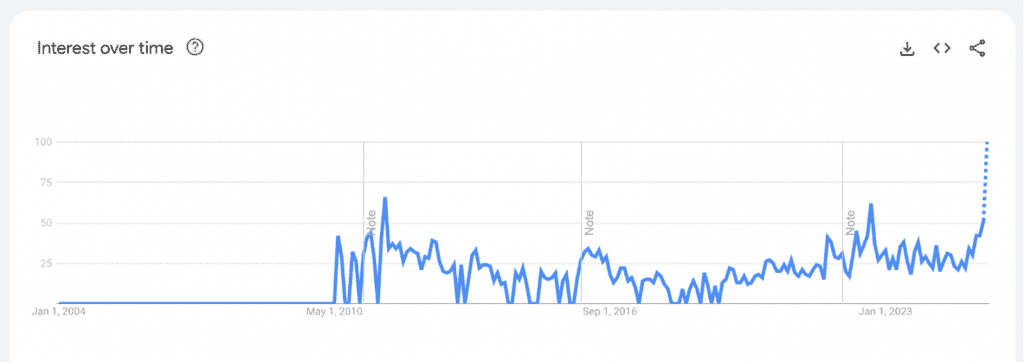
Simple: because honest link providers DO exist — and the scammers are just trying to cash in on their success.
Fancy a 360° view on how to buy quality backlinks without landing in hot water? This post will walk you through:
👉 5 Best places to buy backlinks: INSERT.LINK, Editorial.Link, Stan Ventures, uSERP, Fat Joe
👉 What buying backlinks online actually involves
👉 Reasons why people still buy backlinks for SEO
👉 Major red flags when buying backlinks
👉 Common FAQ on buying high-quality backlinks
1. INSERT.LINK
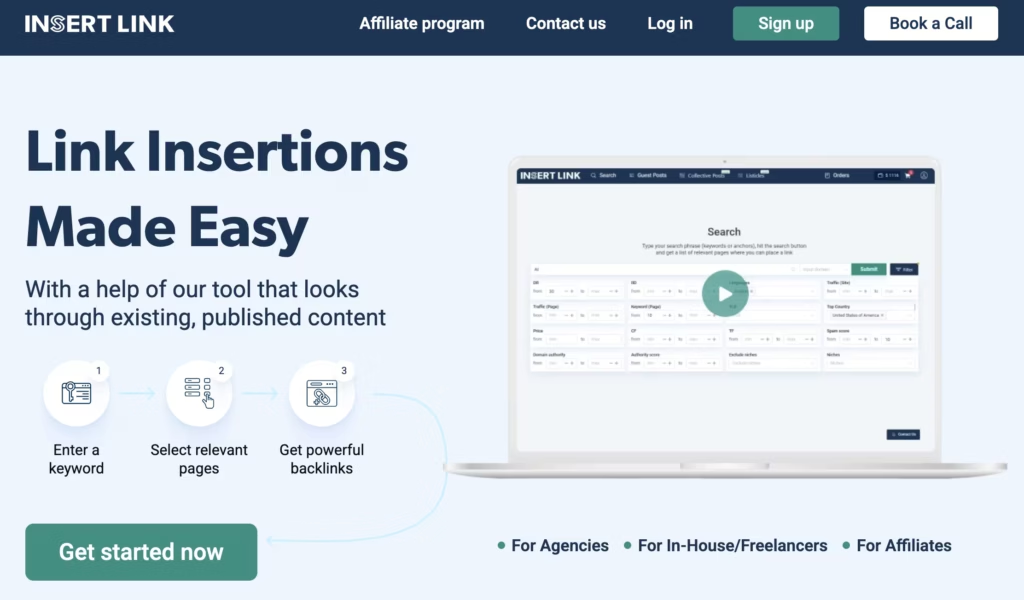
INSERT.LINK is a backlink marketplace powered by an AI search tool that scans millions of pages to instantly match you with trusted, high-authority sites and get you the best link placement opportunities in practically any niche out there.
It also includes Google NLP-based search for link insertions, allowing you to find pages by topical relevance, not just keywords.
For those looking to buy quality backlinks with a safety guarantee, it’s a bulletproof alternative to the typical online offerings — link insertions bring results from day one by drawing on existing traffic and the authority of high-performing content.
⚙️ Services
INSERT.LINK mainly focuses on link insertion services, but what sets this backlink marketplace apart is its impressive reach across a wide range of niches.
Its search tool sifts through an extensive database of 23 million pages across 152 locations and over 45,000 websites — so anyone looking to buy SEO backlinks can be confident there’s always a perfect fit, even for the narrowest niches.
Besides niche edits, INSERT.LINK lets you search in real time for guest post opportunities.
🧐 Why buy links from INSERT.LINK
Not only are link insertions Google-compliant — INSERT.LINK makes them smarter, faster, and more effective.
Here’s why:
👍 No manual search, no outreach, no tedious pitching — INSERT.LINK already connects you with trusted sites featuring well-ranking content that passes traffic and authority your way.
👍 Link data transparency & safety — the tool shows link performance stats, sources, and key metrics upfront, so you can buy backlinks based on your own criteria. Full control, zero guesswork.
🧠 Smart choice! INSERT.LINK is one of the most user-friendly backlink marketplaces out there. All you need is:
👣 Step 1: Create your buyer account.
👣 Step 2: Head to your dashboard and use the link insertion or guest posting search bar — just enter your keyword or anchor text, say “link-building” or whatever you're targeting.

💡Pro tip: You can fine-tune your search by setting filters like desired DR, traffic, country, authority score, and more — so you only see placements that match your exact needs.
👣 Step 3: Run your search and instantly get detailed placement options — domain authority, relevance, content type, traffic, keywords, and more — so you can quickly decide which placements deserve your attention.
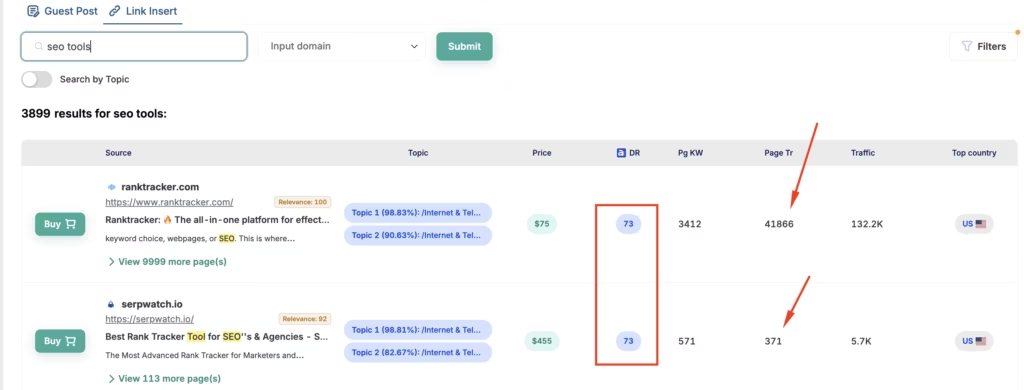
💡Pro tip: Next to each placement, you’ll find a pricing range that lets you place bids based on the data you see. This way, you can evaluate and negotiate like on eBay, making link buying more transparent and totally within your budget.
👣 Step 4: When you’re happy with the placement and price, just click “Buy Backlinks” — and you’re all set.
👍 Fast turnaround — see your link insertions go live within just 1–3 days post-purchase, and guest post placements in as little as 4–7 days — a clear alternative to vendors who make you wait weeks (or even months) for your links to appear.
👍 Affordability — INSERT.LINK offers collective bidding to lower costs on high-value placements; however, you can always opt for fixed-price link inserts starting at just $10!
🏅Awards and client reviews
You can explore INSERT.LINK’s reputation on trusted product platforms.
For example, DesignRush recently named it among the Top Link-Building Agencies of 2025, with many satisfied customers praising its performance too.

2. Editorial.Link

Editorial.Link is an award-winning link-building service focused on digital PR and link earning, helping companies grow rankings safely and consistently with clean outreach and modern AI-driven link building.
⚙️ Services
Editorial backlinks are their specialty — unique placements in top-performing content on sites averaging DR 67 — NO RESELLS, all earned through trusted, long-term relationships with owners and editors.
If editorial links aren’t your main priority, you can still take advantage of Editorial.Link’s other popular services — completely risk-free:
👉 White label link-building — a go-to solution for agencies and enterprises that need to buy quality backlinks in bulk to scale SEO and strengthen brand visibility.
👉 Saas link-building services — a practical way for SaaS brands to build strong domain authority through links from major SaaS outlets and stand out with their products in this “dog-eat-dog” niche.
👉 Listicle link-building — buying backlinks in high-authority listicles can significantly change how AI models perceive your brand, especially how often you appear in Google’s featured snippets and “best online answer” sections.
💡Pro-tip! Google favors concise, well-structured, and easily scannable content like listicles, taking information within them as trusted recommendations. As a result, Google often includes listicles in Google’s AI Overviews.
Hence, if your brand’s link is frequently mentioned in relevant listicles, AI models interpret this as a strong signal to recommend your product, service or solution.
🧐 Why buy links from Editorial.Link
What makes them the best place to buy backlinks is their transparency — from link-building methods to client process.
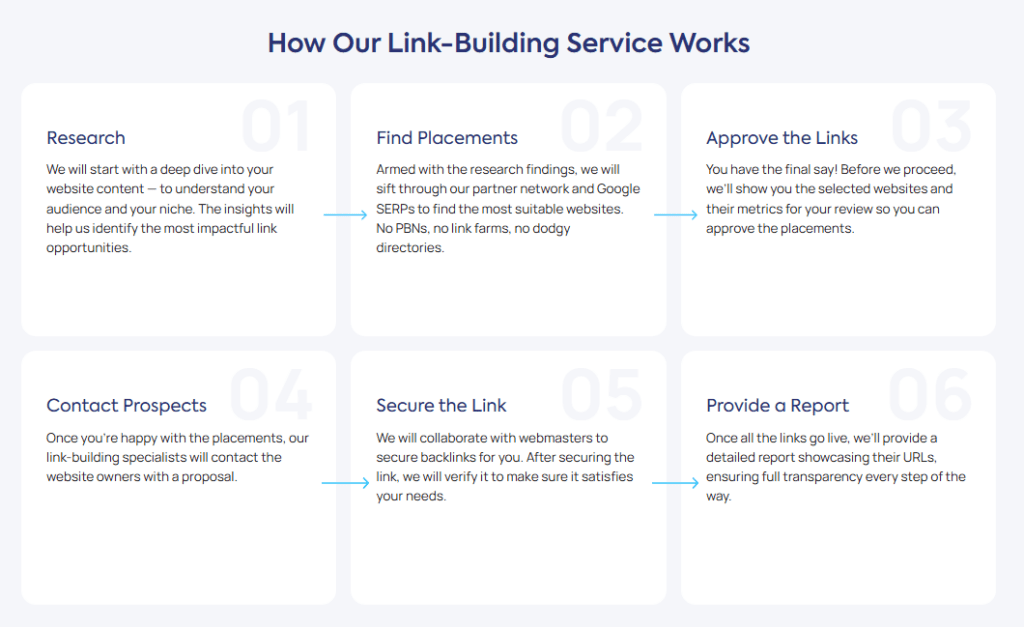
Here’s what’s in it for you if you give their services a go:
👍 Clean link-building, reputation first — Editorial.Link uses only 100% white hat link-building techniques: no PBNs, link farms, trashy directories, or dead-end websites.
👍 Again, NO RESELLS — when you buy SEO backlinks from Editorial.Link, you’re investing in fresh, bespoke links sourced by their team, not second-hand ones that’ve been sold and resold by multiple vendors for years.
👍 Target pre-approval — a rare occurrence in link acquisition services. Clients can handpick preferred target from a given prospect list, and ONLY when satisfied with the metrics does the team proceed.
👍 No upfront fees — instead of locking clients into a full package of 5-10-20 links right away, Editorial.Link offers a trial backlink first — so they know for sure what they’re getting before committing to anything.
👍 Diligent project support & link delivery — every project gets a dedicated account manager, and you can expect your first batch of live links within a month of starting collaboration.
🏅Awards and client reviews
You’ll always recognize the best place to buy backlinks by the public praise from those who’ve already succeeded with a particular link-building service.
One of the easiest ways to check its reputation is through review platforms like Clutch, DesignRush, G2, and others. Editorial.Link is regularly recognized as "Best Link-Building Agency" by many of these — check it out for yourself.
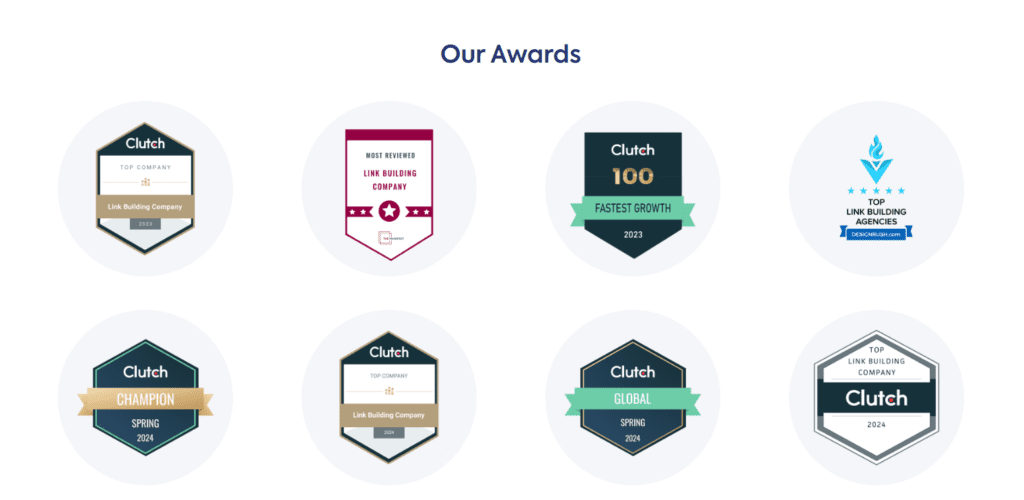
💡Pro-tip! If you’re curious about others’ experiences, don’t hesitate to check the comment sections on these platforms — you’ll see exactly how the service helped users tackle challenges like yours.
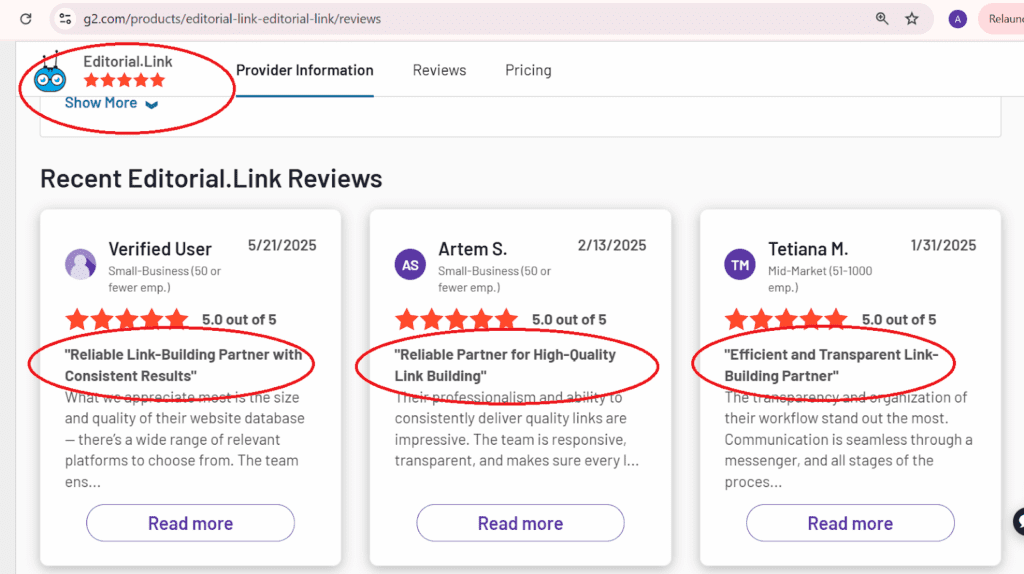
A major trust indicator is the service’s website testimonials and case studies — they not only showcase practical methods, but also reveal the type of clients and their willingness to stake their reputations on the service.
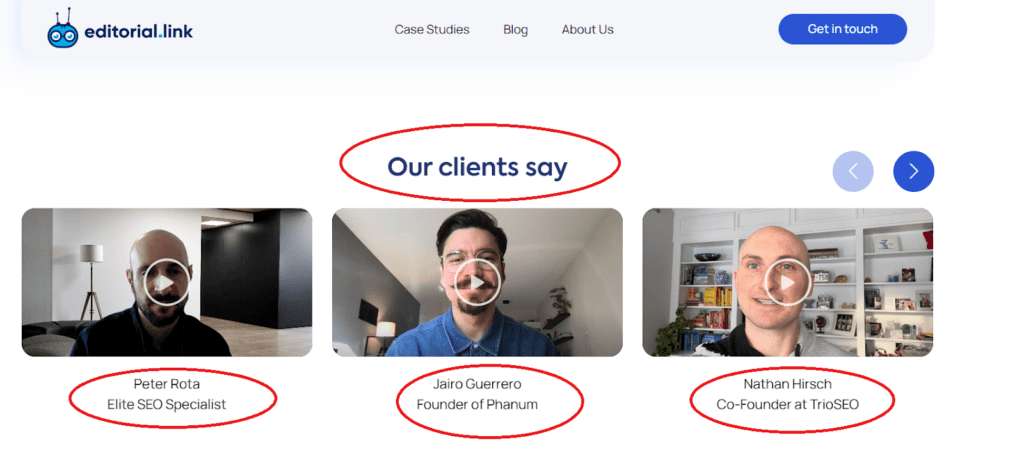
In this regard, all Editorial.Link’s clients aren’t ordinary — they’re big names across multiple industries. Take a look!
3. Stan Ventures

Stan Ventures is one of the most trusted link-building partners for agencies, brands, and marketers who want more than just backlinks — they want measurable growth. Stan Ventures delivers white-label SEO solutions that combine personalized communication with scalable, cost-efficient execution.
This unique hybrid model has made Stan Ventures the go-to partner for 1,000+ marketing teams across 30+ industries — from SaaS and finance to healthcare, education, and e-commerce.
⚙️ Services
Stan Ventures offers a full suite of link-building services, all designed to improve rankings safely and sustainably:

👉 Powerful Backlink Service – Real editorial placements on niche-relevant websites with genuine traffic and authority.
👉 Blogger Outreach – Personalized outreach campaigns that secure high-quality backlinks through authentic relationships.
👉 White-Label Link Building – Agencies love this hands-free option — scalable, transparent, and ready to resell under their brand.
👉 Niche Edits Links – Get contextual backlinks placed within existing, high-authority Google-indexed articles. They help boost rankings faster since the pages already have traffic and trust.
👉 Brand Mention Services – Designed for the new era of Google AI Overviews and Generative Search, helping brands get cited and visible in AI results.
🧠 Why Choose Stan Ventures
👍 100% White-Hat Practices – Every link is earned through manual outreach, genuine relationships, and editorial acceptance — no PBNs, no shortcuts, no risk.
👍 Real Websites. Real Traffic. – Stan’s proprietary vetting process ensures that every site has authentic organic traffic, verified via Ahrefs and Semrush.
👍 Dedicated Project Managers – Enjoy seamless communication, project tracking, and proactive reporting, with execution handled by dedicated SEO specialists for cost efficiency.
👍 Custom Strategy for Every Campaign – Whether you’re an agency scaling clients or a brand protecting reputation, Stan builds link strategies aligned with KPIs — not vanity metrics.
👍 Transparent Reports and Link Replacement Guarantee – Pre-approval for sites and content with full access to DR, traffic, and anchor data, with free replacements for any lost links within 12 months.
🏅 Awards & Recognition
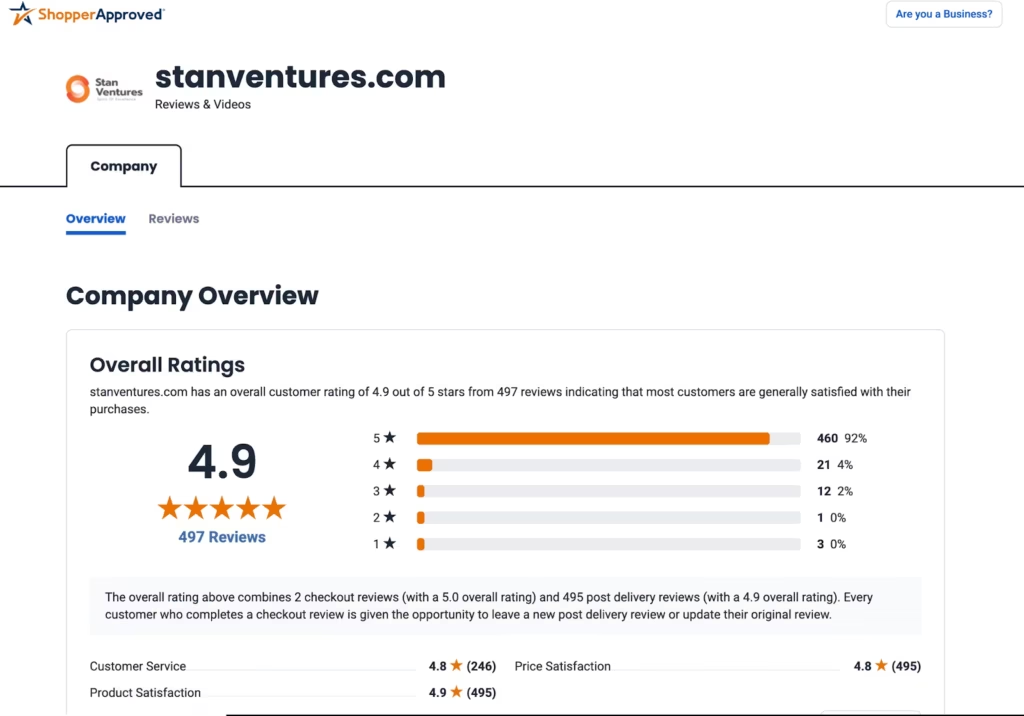
Stan Ventures has been featured in Search Engine Journal, Semrush, Ahrefs, Entrepreneur, and HubSpot, and consistently ranks among the Top Link-Building Companies on DesignRush and multiple other platforms.
It has 500+ Reviews on Shopper Approved with 4.9 rating, which signifies the quality of their link building services.
Their client portfolio includes agencies and enterprises that trust Stan as an extension of their team — delivering over 80,000 successful campaigns and counting.
💡 Pro Tip: If you’re an agency or brand tired of unreliable vendors and poor communication, Stan Ventures gives you both — scalability and strategy — without compromising quality or trust.
4. uSERP
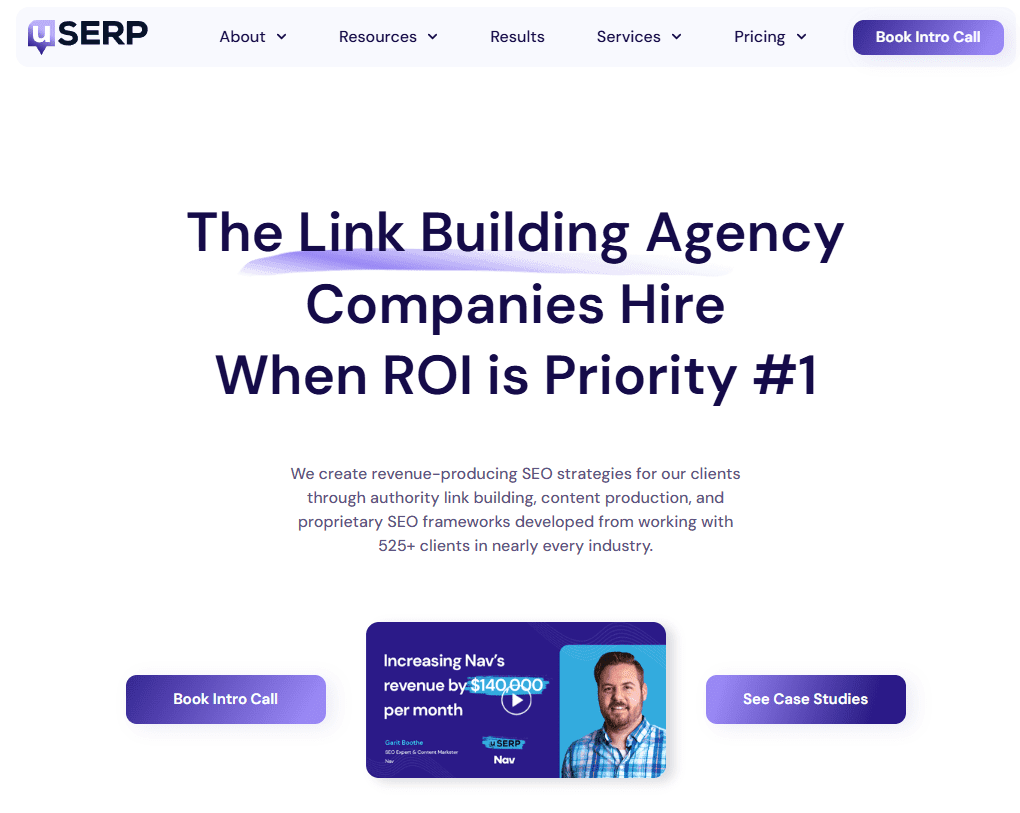
Since 2019, uSERP has built a strong reputation as a top-tier link-building agency — assisting over 525 major brands across nearly every industry in scaling their organic growth through high-authority backlinks and results-driven SEO.
⚙️ Services
👉 Link-building services (any niche) — delivering authoritative backlinks that drive growth in MRR, qualified leads, and targeted organic traffic using white-hat strategies.
👉 Comprehensive SEO services for SaaS brands & agencies — uSERP acts like an external marketing team for Saas brands willing to improve their overall SEO strategy, technical SEO, content creation, and digital PR to drive faster, tangible results and stand out in the competitive SaaS space.
🧐 Why buy links from uSERP
uSERP proves to be one of the best places to buy backlinks because of:
👍 Proven expertise — uSERP first launched its link-building services to support its own SEO agency, setting a high standard for link quality and gaining firsthand insight into what clients truly need in a reliable link-building partner.
👍 Efficiency — uSERP’s link-building services focus solely on high-authority backlinks through a white-hat, content-driven approach — designed to hit key KPIs, not just pump up link counts.
👍 Revenue Focus — they prioritize strategies that drive real prospects to websites by targeting high-intent, research-driven keywords.
👍 No Vanity Metrics — uSERP starts by analyzing traffic potential and CPC, then focuses on priority KPIs to ensure every effort drives real customer acquisition.
🏅Awards and client reviews
When it comes to link-building services, uSERP has earned widespread recognition for at least five consecutive years from product review and feedback platforms like Clutch, Growth Ramp, and DesignRush, etc. consistently ranking in the “Top Link-Building Company” nominations.
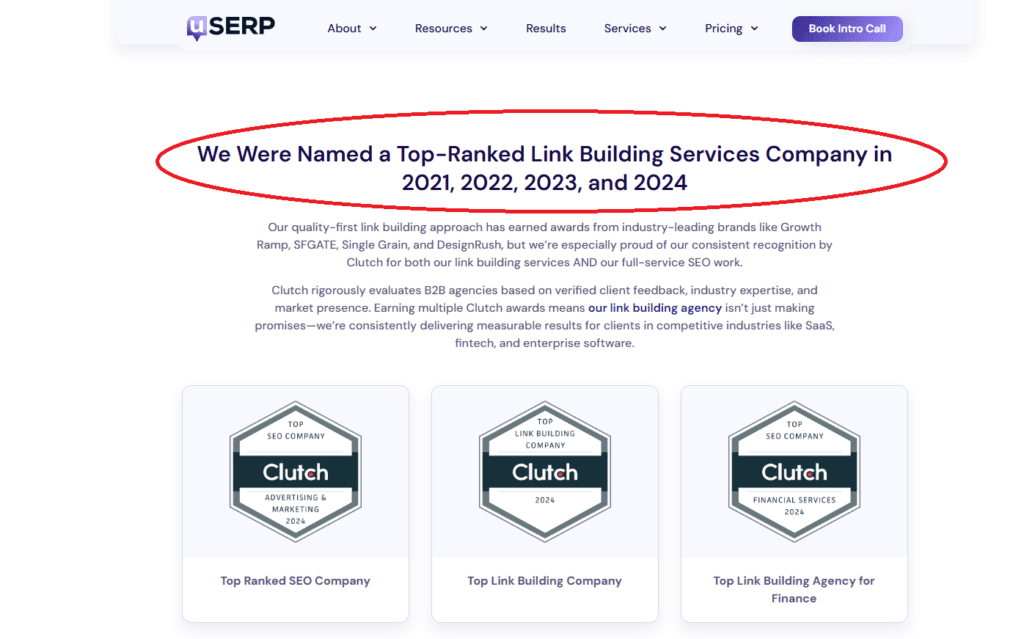
As for results few services can boast, uSERP’s combination of SEO expertise and premium link building has helped brands like Monday.com grow from Series B to a unicorn IPO. Impressive!
And the big names don’t stop there — you can explore many more success stories from Nav, Preply, Glassbox, and others in uSERP’s extensive case study section.
5. Fatjoe
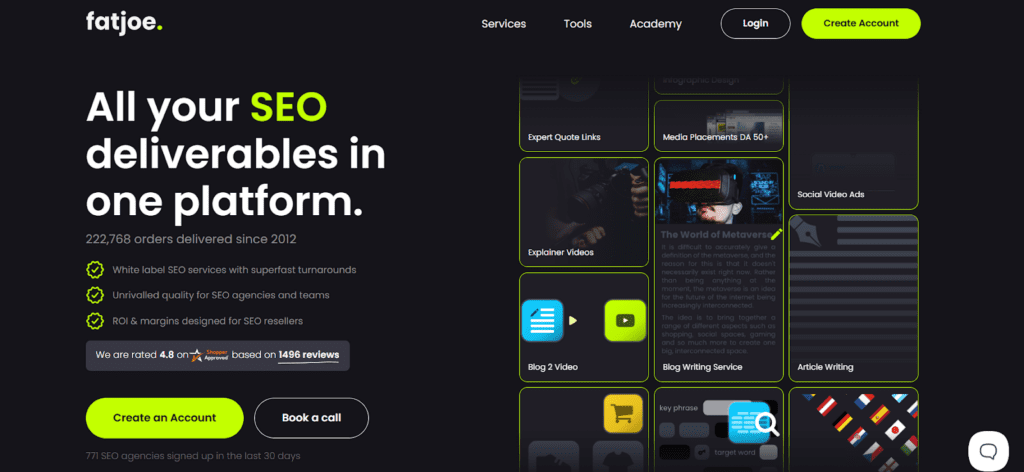
Fatjoe is a globally recognized marketplace where businesses, brands, and individuals can outsource high-demand marketing and SEO deliverables, including link-building services.
This platform is ideal for those who already understand the basics of SEO and want to scale their output — whether for clients or in-house — without the need to hire additional staff or add operational complexity.
⚙️ Services
At FatJoe, you can outsource major digital marketing services at scale — everything from link-building and digital PR to SEO, content writing, plus design and video.
Say you’re looking to buy SEO backlinks on the platform — you’ll get to choose from blogger outreach, iGaming links, niche edits, infographic outreach, and even multilingual placements.
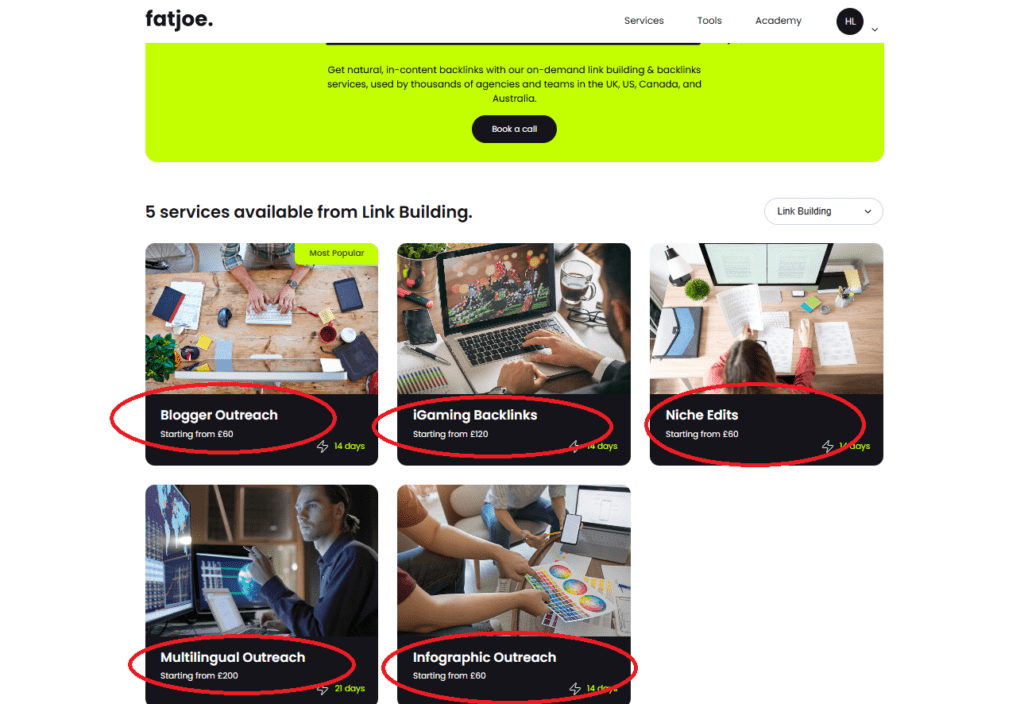
For your convenience, all links are manually sourced by Fatjoe’s expert teams — just place your order, and they’ll take care of the rest.
💡Pro tip: Once you choose your preferred link type — say, niche edits — you simply select the number of links you need based on DR, which typically ranges from 10 up to 60. Each option shows the estimated price per link, along with the total cost for your entire order, so you know exactly what you’re paying for upfront.
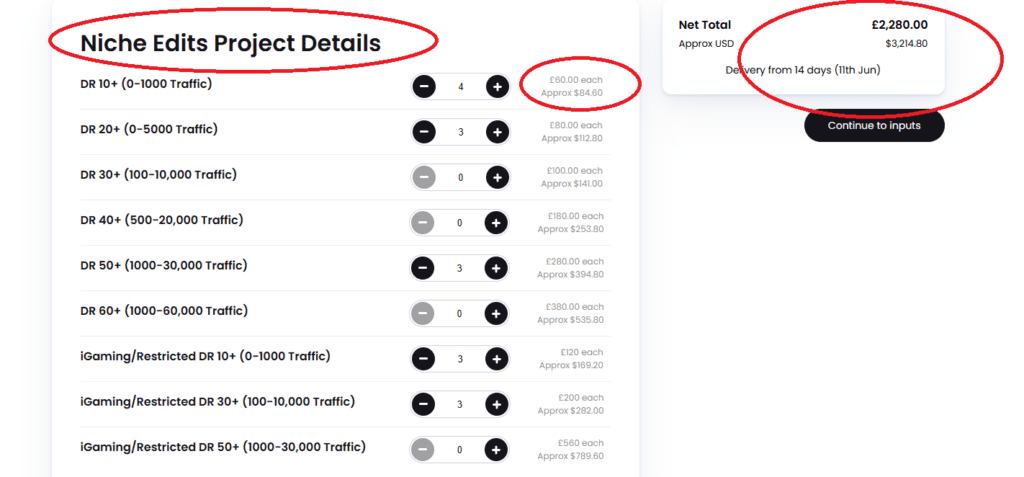
🧐 Why buy links from Fatjoe
FatJoe’s SEO deliverables shop is not just a smart way to scale your SEO needs without the headache of long hiring processes — it also offers a bunch of other perks:
👍 You’re buying high-quality backlinks specially sourced for resale, so whether you’re an independent pro or an agency, you can easily offer them under your own name later in time.
👍 All links are manually sourced by Fatjoe’s expert team through personal outreach and strong, long-term relationships with site owners and editors. So you get clean, safe, high-quality links every time.
👍 Whenever you buy links from Fatjoe, you’ll see clear, upfront pricing — no hidden fees. Just pick what fits your budget.
👍 You get direct access to placement performance reports right in your personal dashboard — everything you need, all in one place.
🧠 Smart choice! Each placement shows its delivery window — from as fast as 2 days up to 28 — so you decide on the timing. Need your links to go live sooner? Just add the “Express” option for a small extra fee to speed things up.
👍 If you don’t receive any links after purchasing from Fatjoe, you’ll get a 100% guaranteed refund.
🏅Awards and client reviews
For starters, you can check out plenty of glowing reviews right on Fatjoe’s platform — from real users who’ve tried the service and loved it.
You’ll also find solid word-of-mouth for Fatjoe on established review sites like Trustpilot (rate 4.8 out of 5), Google Reviews (rate 4.3 out of 5), or Shopper Approved (rate 4.8 out of 5), where thankful clients share their experiences.
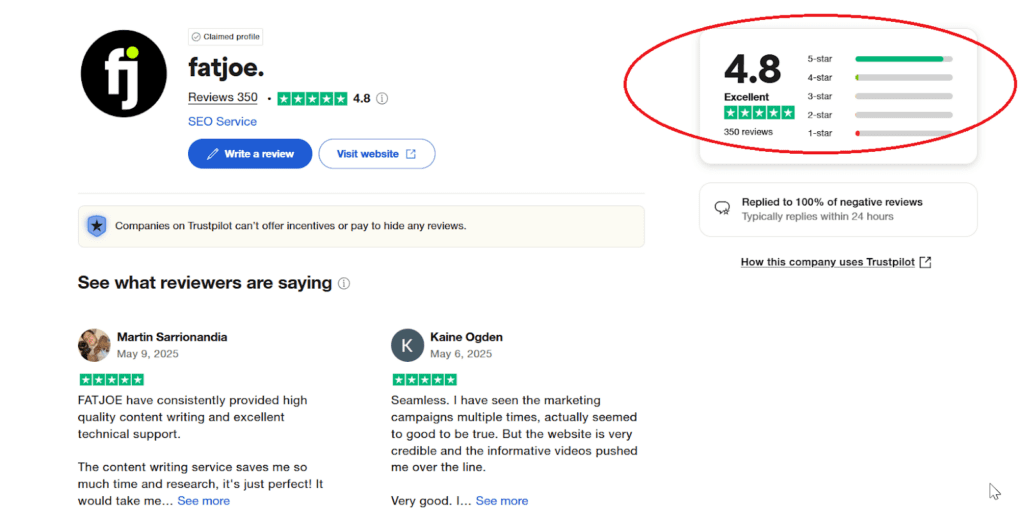
Buying Backlinks: How Does It Work?
It’s exactly what it sounds like — buying links means PAYING directly to website owners, editors, or content creators to add a link from their high-performing content to your site.
In return, you’re aiming for more clicks, traffic, and exposure to new audiences — signals that show Google your site is trustworthy and deserves a higher spot in the rankings.
As we mentioned earlier, you can also buy links from established providers who handle the outreach and place your link on relevant, niche-specific sites — for money, of course.
Either way, you turn to paid links when organic outreach is too slow, your business needs have outgrown it, or you need to ramp up SEO performance fast.
Why Do People Still Buy Backlinks?
The most common reason is also the most obvious: speed. Despite the risks — like weird link sellers or potential Google penalties — many choose to buy links to get fast SEO results when timing is critical.
Relying solely on organic link-building can really hold you back — you CAN’T whip up high-quality backlinks in a day.
Based on our research, roughly 56% say Google still struggles to identify and neutralize paid links.

On top of that, no matter how much Google tries to deny the impact of links on rankings, real-world experience says otherwise — links still matter.
Alright — beyond speed, here are a few more reasons people still buy SEO backlinks despite the risks:
80/20 Rule: Less Action, More Results
Yep, that’s the classic Pareto Principle: 20% of your efforts deliver 80% of your results. When you buy high-quality links, all the heavy lifting’s done behind the scenes — creating link-magnet content, negotiating with capricious, authoritative sites, researching potential sources, you name it.
That 20% effort is basically finding a reliable provider who can actually deliver high-quality links. The other 80%? Not your problem, you’re buying links to free yourself from the burden of extra work that entails one single link to focus on other business priorities.
Firm Grip on Link Placement
Almost every SEO and link builder is a total control freak when it comes to their links. And honestly, if it takes forever to score a high-quality one, no one wants to see it disappear tomorrow or get buried in some forgotten corner of a blog no one’s visited since 2007.
Fair enough! That’s the upside of buying links — you know exactly when, where, how, and why they’ll be placed. From the anchor text to the surrounding content, everything is tailored to fit your strategy. After all, you're the one footing the bill!
💡Pro tip: When you're doing organic link-building outreach, no matter how hard you try, the future of your link — let alone the anchor text — is entirely in the hands of whoever was kind enough to link to you in the first place.
However, when you buy links, your budget buys you access to premium spots on the kind of websites you wouldn’t dream of landing on your own — and on your terms!
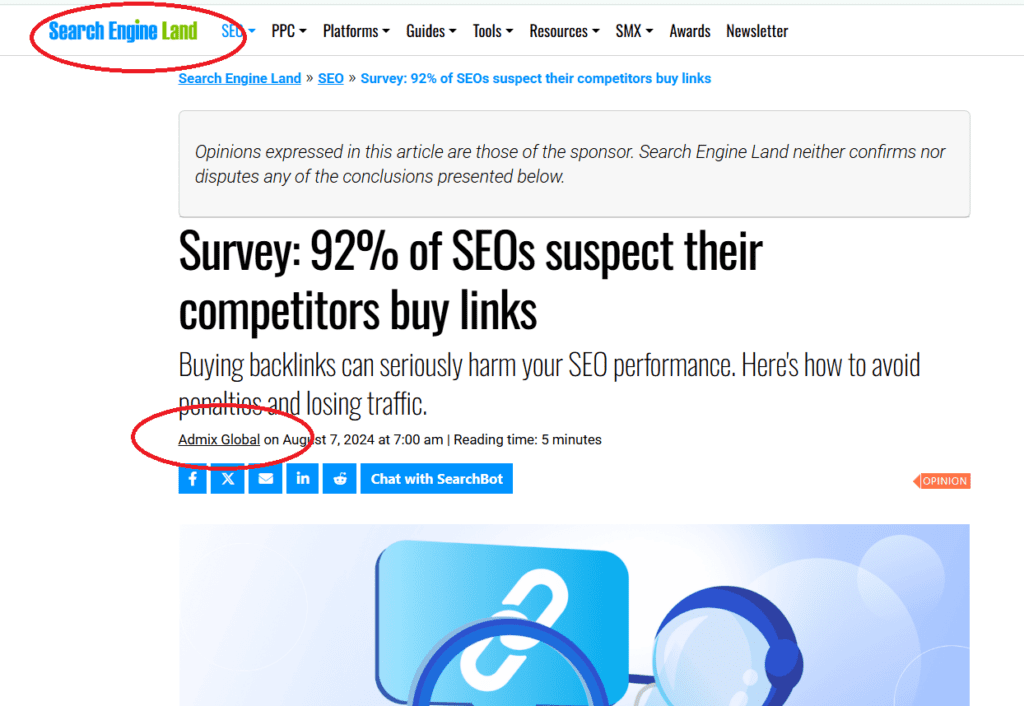
Red Flags When Buying Backlinks
Thinking about buying SEO backlinks already? Before you do, tattoo these red flags on your brain — so you stay sharp and safe!
Links-on-a-dime
Another day, another “successful” LinkedIn pitch promising big SEO wins from link packages just for 1 cent. Too tired even to report these crooks. Pretty sure, you too!
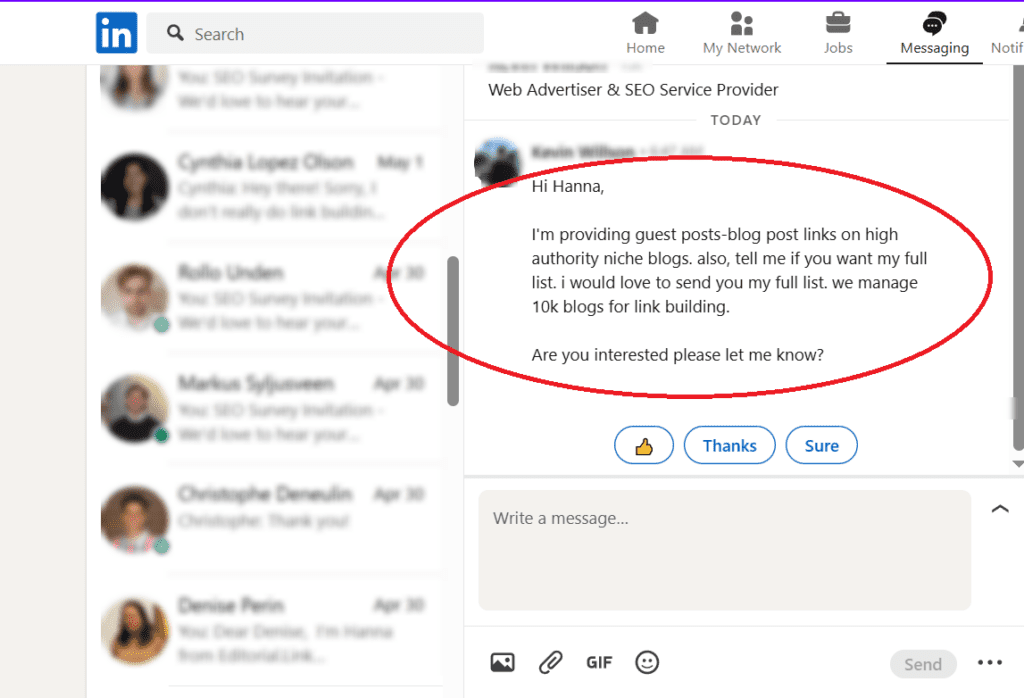
Not to mention those pop-up ads hawking “top-tier” link bundles — like 10,000 backlinks for just $25. Yeah, you can totally trust that 🤡
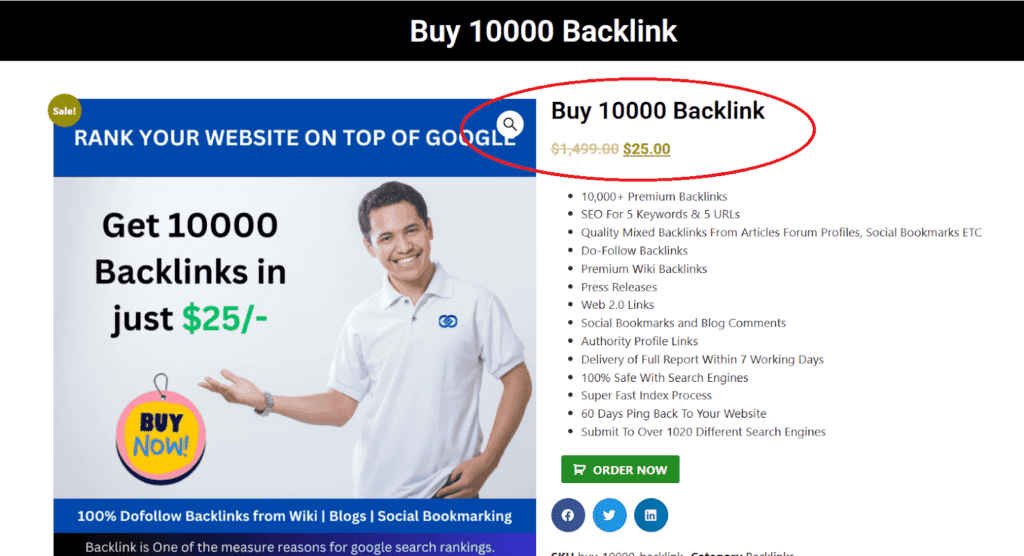
Remember, if you’re not building links yourself, good ones come with a price. Cheap shortcuts like those above? They’re a fast track to hurting your SEO and damaging your site’s reputation.
Relying on Fiverr Link-Building “Experts”
Don’t get me wrong — there’s nothing wrong with outsourcing your SEO tasks to Fiverr pros. In fact, plenty of them do solid, honest work.
But use some critical thinking when picking your contractors. Do you really think anyone’s gonna spend weeks landing you a link from Search Engine Land for just $5? 🤡
Nope — run away. Say it twice: it’s not your lucky day dealing with those. Your website might pay the price after one dodgy link.
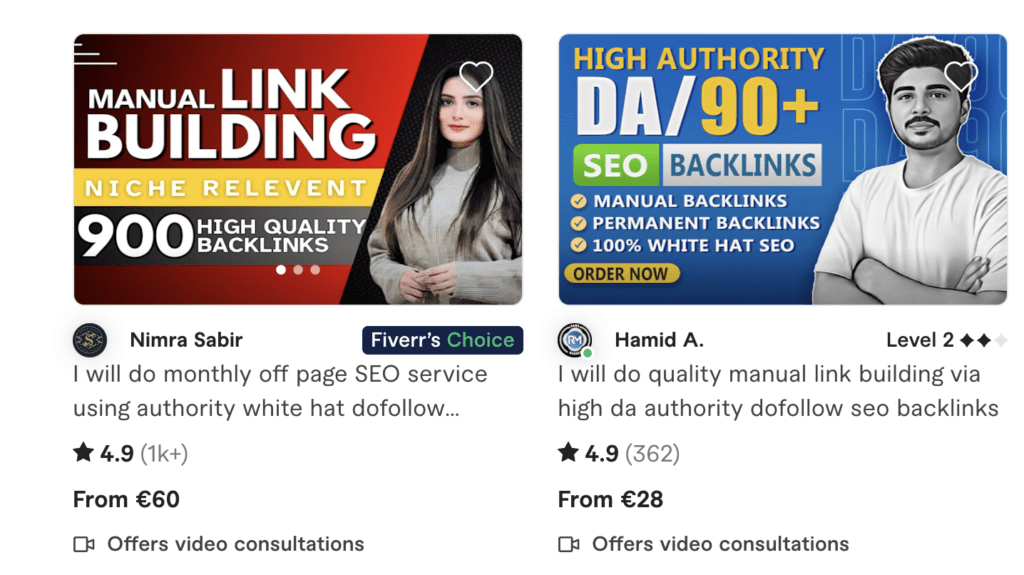
Again, quality comes at a price, especially in link-building. If you’re on a budget and falling behind, at least look for freelancers who offer a fair market rate and have solid reviews. That way, you’re more likely to get results without risking your SEO.
Link Farms. Literally… In 2026!
You’re not wrong — believe it or not, even in 2026, many are still trying to tweak their SEO by messing around with link farms.
What’s worse?
From my experience, around 90% of link-building agencies are still pushing link farm links as a service!
To keep yourself safe, always watch out for these red flags that scream “link farm”:
❌ A bunch of links with almost the same number of referring domains
❌ Sites showing very similar DR
❌ High traffic numbers but zero real value or engagement
❌ Selling backlinks across every niche without focus
PBNs
If you’ve never come across them, just know, Private Blog Networks (PBNs) are disguised versions of link farms, built from multiple sites owned by the same entity.
But don’t worry — you can bust PBNs by the same red flags as link farms: unusually high DA/DR, low traffic, few (if any) top-ranking keywords, and barely any real page visits.
If you buy links, make sure none of these warning signs show up. One shady link can cost you more than it’s worth.
💡Pro tip: However, you can’t be categorical about PBNs once and for all. In certain industries — like gambling, for example — they can be highly effective at passing link juice to niche platforms.
Buying Backlinks: FAQ
Now, let’s see some quick Q&As you might still be curious to peek at when it comes to buying backlinks for SEO.
Is it safe to buy backlinks?
Yes, why not?
Technically, Google’s against paid links — but there’s plenty of gray area. Buying backlinks can still work if you’re doing it through trusted, high-authority sites using things like sponsored content, guest posts, link insertions, advertorials, link rentals, product reviews, or listicles.
Plus, our own 2025 State of Link-Building Survey showed that 91.9% of SEO experts believe their competitors are buying backlinks. That’s a strong signal — it’s not something to be afraid of, everyone does it here and there.

What should I look at when buying backlinks?
When buying backlinks, you need to pay close attention to the SEO health and context of the site you’re linking from. Key factors to consider include:
- How relevant the site’s niche is to your own website and content
- Domain Authority and Trust Flow scores
- The site’s traffic volume
- Where the link is placed and the quality of the surrounding content
- How natural the anchor text looks
- The site’s spam levels, content quality, amount of ads, and number of outbound links
- Whether the site has ever been penalized — and why
- Transparency around link pricing — watch out for any hidden fees
Are there specific industries where buying backlinks works better?
Sure, there are industries where buying backlinks isn’t just helpful — it’s a lifeline. In highly competitive spaces, standing out means ranking higher, and that often comes down to trust signals like high-quality backlinks that tell Google your site is worth showing.
Some of the most competitive industries where buying links can make a big difference include:
- Tech & SaaS
- Casino
- Finance & Crypto
- Travel
- E-commerce
- Legal
- Health & Wellness
- Online Education
- Real Estate
- iGaming
- Beauty & Fashion
- Insurance
How can I tell if a backlink seller is trustworthy?
👉 First, a trustworthy backlink seller is fully transparent
They’ll openly share all the important details up front — things like link metrics, content quality, source sites, niche relevance, and how the links are actually built. Nothing should feel vague or hidden. You should be able to verify everything for yourself before committing.
👉 Another key sign: clear, open communication
A trustworthy seller won’t ghost you when you ask questions — especially about things like pricing, placement, or turnaround times. Payment shouldn’t be required upfront before the links go live. Plus, sellers who provide detailed reports after placement show they’re serious and professional about what they do.
👉 And finally — look for real feedback and case studies
Word of mouth, verified reviews, and actual results from people who’ve used their service will tell you more than any sales pitch. If others have seen success (and can prove it), it’s a strong sign you’re dealing with someone trustworthy.
Final Words
As much as Google warns against buying backlinks, let’s be honest — everyone does it. The real question isn’t if you buy links, but how you do it. Are you making rookie mistakes and buying from crooks? Or are you doing it the smart way — through trusted sources, relevant placements, and methods that fly under Google’s radar?
If you’re new to link building or still on the fence, it’s smarter to leave it to the pros. A trusted link building service like Editorial.Link takes the guesswork (and risk) out of the process. You’re not just buying links — you’re buying peace of mind.

